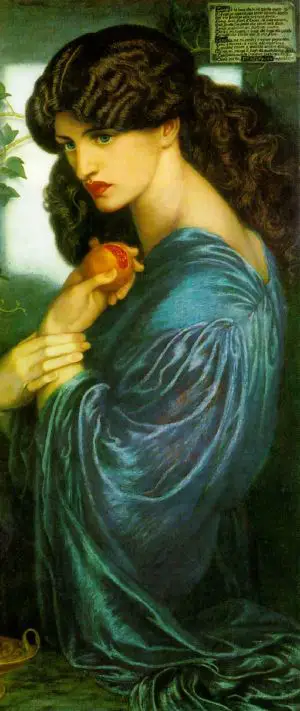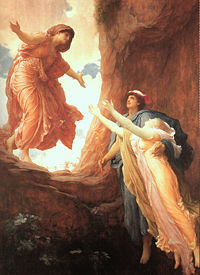Persephone

In Greek mythology, Persephone (Greek Περσεφόνη, Persephónē) was the Queen of the Underworld of epic literature. In other dialects she was known under various other names: Persephassa, Persephatta, or simply Kore (Greek κόρη, "daughter") (when worshipped in the context of Demeter and Kore).
The Romans first heard of her from the Aeolian and Dorian cities of Magna Graecia, who use the dialectal variant Proserpina. Hence, in Roman mythology she was called Proserpina, and as a revived Roman Proserpina she became an emblematic figure of the Renaissance.
In Greek art, Persephone/Kore is invariably portrayed robed. She may be carrying a sheaf of grain and smiling demurely with the "Archaic smile" of the Kore of Antenor.
The figure of Persephone is well-known today. Her story has great emotional power: an innocent maiden, a mother's grief at the abduction, and the return of her daughter. It is also cited frequently as a paradigm of myths that explain natural processes, with the descent and return of the goddess bringing about the change of seasons.
In a text ascribed to Empedocles describing a correspondence between four gods and the classical elements, the name Nestis for water apparently refers to Persephone.[1] "Now hear the fourfold roots of everything: Enlivining Hera, Hades, shining Zeus. And Nestis, moistening mortal springs with tears".
Of the four gods of Empedocles' elements it is the name of Persephone alone that is taboo, for the Greeks knew another face of Persephone as well. She was also the terrible Queen of the dead, whose name was not safe to speak aloud, who was named simply "The Maiden". In The Odyssey, when Odysseus goes to the Underworld, he refers to her as the Iron Queen. Her central myth, for all of its emotional familiarity, was also the tacit context of the secret initiatory mystery rites of regeneration at Eleusis, which promised immortality to their awe-struck participants — an immortality in her world beneath the soil, feasting with the heroes beneath her dread gaze (Kerenyi 1960, 1967).
The abduction myth
In the Olympian pantheon, Persephone is given a father: according to Hesiod's Theogony, Persephone was the daughter produced by the union of Zeus and Demeter. "And he [Zeus] came to the bed of bountiful Demeter, who bore white-armed Persephone, stolen by Hades from her mother's side".
Unlike every other offspring of an Olympian pairing, Persephone has no stable position at Olympus. Persephone used to live far away from the other gods, a goddess within Nature before the days of planting seeds and nurturing plants. In the Olympian telling [1], the gods Hermes, Ares, Apollo and Hephaestus, had all wooed Persephone, but Demeter rejected all their gifts and hid her daughter away from the company of the gods. Thus, Persephone lived a peaceful life before she became the goddess of the underworld, which, according to Olympian mythographers, did not occur until Hades abducted her and brought her into the underworld. She was innocently picking flowers with some nymphs—and Athena and Artemis, the Homeric hymn says—, or Leucippe, or Oceanids— in a field in Enna when he came, bursting up through a cleft in the earth; the nymphs were changed by Demeter into the Sirens for not having interfered. Life came to a standstill as the devastated Demeter (goddess of the Earth) searched everywhere for her lost daughter. Helios, the sun, who sees everything, eventually told her what had happened.
Finally, Zeus, pressured by the cries of the hungry people and by the other gods who also heard their anguish, could not put up with the dying earth and forced Hades to return Persephone. But before she was released to Hermes, who had been sent to retrieve her, Hades tricked her into eating four pomegranate seeds, (or six, or three according to some versions of the myth) which forced her to return to the underworld for one month each year for every seed that she ate. In some versions, Ascalaphus informed the other gods that Persephone had eaten the pomegranate seeds. When Demeter and her daughter were together, the Earth flourished with vegetation and color, but for four months each year, when Persephone returned to the underworld, the earth once again became a barren realm of darkness. This is an origin story to explain winter.
While Persephone was in the Underworld, Hades made Persephone marry him. Also while the earth was in the season winter, she lived with him, and for the rest of the year she lived with her mother and father.
In an alternate version, Hecate rescued Persephone. In the earliest version the dread goddess Persephone was herself Queen of the Underworld (Burkert, Kerenyi).
In some versions, Demeter forbids the earth to produce, in others she is so busy looking for Persephone that she neglects the earth, and in some the depth of her despair causes nothing to grow.
The number of pomegranate seeds varies in different versions of the story, corresponding with the number of months considered as winter months.
This myth can also be interpreted as an allegory of ancient Greek marriage rituals. The Greeks felt that marriage was a sort of abduction of the bride by the groom from the bride's family, and this myth may have explained the origins of the marriage ritual. The more popular etiological explanation of the seasons may have been a later interpretation.
Persephone, as Queen of Hades, only showed mercy once, because the music of Orpheus was so hauntingly sad. She allowed Orpheus to bring his wife Eurydice back to the land of the living as long as she walked behind him and he never tried to look at her face until they reached the surface. Orpheus agreed but failed, looking back at the very end to make sure his wife was following, and lost Eurydice forever.
Persephone also figures in the story of Adonis, the Syrian consort of Aphrodite. When Adonis was born, Aphrodite took him under her wing, seducing him with the help of Helene, her friend, and was entranced by his unearthly beauty. She gave him to Persephone to watch over, but Persephone was also amazed at his beauty and refused to give him back. The argument between the two goddesses was settled either by Zeus or Calliope, with Adonis spending four months with Aphrodite, four months with Persephone and four months of the years on his own.
When Hades pursued a nymph named Mintho, Persephone turned her into a mint plant.
Persephone was the object of Pirithous's affections. Pirithous and Theseus, his friend, pledged to marry daughters of Zeus. Theseus chose Helen and together they kidnapped her and decided to hold onto her until she was old enough to marry. Pirithous chose Persephone. They left Helen with Theseus' mother, Aethra, and traveled to the underworld, domain of Persephone and her husband, Hades. Hades pretended to offer them hospitality and set a feast; as soon as the pair sat down, snakes coiled around their feet and held them there. From Edith Hamilton's Mythology, it is stated as being a "Chair of Forgetfulness" that they sit upon. It should also be noted that Heracles was able to save Theseus from this fate when he was in the Underworld, but Hades forced Pirithous to remain seated forever.
Persephone and her mother Demeter were often referred to as aspects of the same goddess, and were called "the Demeters" or simply "the goddesses." The story of Persephone's abduction was part of the initiation rites in the Eleusinian Mysteries.
Modern scholarship on Persephone
Template:Greek myth (Hades)
Persephone before the Greeks?
Many modern scholars have argued that Persephone's cult was a continuation of Neolithic or Minoan goddess-worship. Among classicists, this thesis has been argued by Gunther Zuntz (Zuntz 1973) and cautiously included by Walter Burkert in his definitive Greek Religion.
More daringly, the mythologist Karl Kerenyi has identified Persephone with the nameless "mistress of the labyrinth" at Knossos.
On the other hand, the hypothesis of a universal cult of the Earth Mother has come under increasing criticism in recent years. For more on both sides of the controversy, see Mother Goddess.
Life-death-rebirth
Inspired by James Frazer, Jane Ellen Harrison and modern mythologers, some scholars have labeled Persephone a life-death-rebirth deity.
Consorts/children
- Heracles
- Zagreus (Some say that Heracles is the father of Zagreus by Persephone but it is usually said that Zeus is his father)
- Zeus
- Zagreus (according to one tradition. See Orphic mysteries) (although sometimes thought of as son of Demeter and not Persephone)
- Hades
- Adonis (according to one tradition, though this is sometimes thought of as a misinterpretation of Aidoneus, an alternate name of Hades)
- Hermes (according to one tradition)
The 1911 Encyclopaedia Britannica account of the myth
"As she was gathering flowers with her playmates in a meadow, the earth opened and Pluto, god of the dead, appeared and carried her off to be his queen in the world below. ... Torch in hand, her sorrowing mother sought her through the wide world, and finding her not she forbade the earth to put forth its increase. So all that year not a blade of corn grew on the earth, and men would have died of hunger if Zeus had not persuaded Pluto to let Proserpine go. But before he let her go Pluto made her eat the seed of a pomegranate, and thus she could not stay away from him for ever. So it was arranged that she should spend two-thirds (according to later authors, one-half) of every year with her mother and the heavenly gods, and should pass the rest of the year with Pluto beneath the earth. ... As wife of Pluto, she sent spectres, ruled the ghosts, and carried into effect the curses of men."
See also
- Proserpina
- Demeter
- Anthesphoria, festival honoring Proserpina, and Persephone
- Eleusinian Mysteries
- Persephone in popular culture
Notes
- ↑ Peter Kingsley, in Ancient Philosophy, Mystery, and Magic: Empedocles and Pythagorean Tradition (Oxford University Press, 1995) identifies Nestis as a cult title of Persephone.
ReferencesISBN links support NWE through referral fees
- Karl Kerenyi (Eleusis: Archetypal Image of Mother and Daughter, 1960, in English 1967)
- Günther Zuntz, Persephone: Three Essays on Religion and Thought in Magna Graecia, 1973
- Walter Burkert, Greek Religion 1985
- Lewis Richard Farnell, The Cults of the Greek States, Volume 3 (1906) (Chapters on: Demeter and Kore-Persephone; Cult-Monuments of Demeter-Kore; Ideal Types of Demeter-Kore).
External links
Credits
New World Encyclopedia writers and editors rewrote and completed the Wikipedia article in accordance with New World Encyclopedia standards. This article abides by terms of the Creative Commons CC-by-sa 3.0 License (CC-by-sa), which may be used and disseminated with proper attribution. Credit is due under the terms of this license that can reference both the New World Encyclopedia contributors and the selfless volunteer contributors of the Wikimedia Foundation. To cite this article click here for a list of acceptable citing formats.The history of earlier contributions by wikipedians is accessible to researchers here:
The history of this article since it was imported to New World Encyclopedia:
Note: Some restrictions may apply to use of individual images which are separately licensed.

